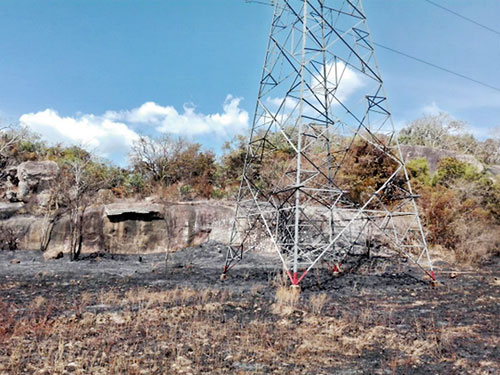News
Did farmers’ fires send the country into darkness?
View(s):CEB probe into outage cause turns up reports of cultivation burnoffs
By Sandun Jayawardana
Authorities are investigating whether fires lit for cultivation purposes caused the tripping of the Anuradhapura-Kotmale transmission line last Saturday. The incident led to the complete shutdown of the 900 megawatt (MW) Lakvijaya coal power plant in Norochcholai, leading to island-wide power cuts over two days.
The Sunday Times learns that Ceylon Electricity Board (CEB) engineers had observed fires on cultivation land at various locations from Anuradhapura to Habarana earlier this month while investigating the tripping of several transmission lines. They had noted in their reports that areas where the tripping had occurred had been heavily burned. The dry weather conditions were also causing wildfires to erupt in these areas, though man-made fires were observed to be more extensive.
CEB Chairman Anura Wijepala it was not certain if such fires were responsible for what happened last Saturday but it was cause for serious concern: setting fires near electricity transmission towers or directly below the transmission lines was extremely dangerous.
 “We are appealing to farmers not to set fires below electricity transmission lines or near transmission towers,” he said. Farmers are currently preparing for the coming Maha season cultivation. This has led to fires being started in various areas to clear vegetation. Large mounds of straw were also being burnt, sometimes directly below transmission lines.
“We are appealing to farmers not to set fires below electricity transmission lines or near transmission towers,” he said. Farmers are currently preparing for the coming Maha season cultivation. This has led to fires being started in various areas to clear vegetation. Large mounds of straw were also being burnt, sometimes directly below transmission lines.
The ash and dust released from these fires accumulate on the insulators of these transmission lines, explained Athula Wanniarachchi, President of the CEB Engineers’ Union. The insulators are designed to obstruct the free flow of electricity. When conditions become a little moist however, such as during morning mist or when light rain is falling, these particles can interact with the moisture, resulting in an electrical short-circuit in the transmission line. The line then “trips” automatically as a safety measure to prevent a fire or any other major damage to the system.
The Lakvijaya Coal Power Plant, more commonly known as the Norochcholai plant, has four transmission lines, with two lines making up one double-circuit transmission line. One of these lines goes towards Veyangoda while the other leads to Anuradhapura.
On Friday, October 14, the day before the incident, the transmission line towards Veyangoda had tripped and had been under maintenance. This meant that all power was being routed through the Anuradhapura-Kotmale line. This line too had tripped on Saturday, resulting in all three units of the power plant shutting down as a precautionary measure.
Once the units shut down, it takes several days to get them operational once more as they have to cool naturally from the intense heat that arises in the event of a shutdown. Officials were able to restart generation in Unit 2 of the plant on Wednesday evening, making it possible to do away with the 1.5-hour power cut that the government had initially said could last until Friday.
CEB officials are now looking to restart generation from Unit 3 by the middle of next week. Unit 1 is likely to take longer to become operational but the CEB Chairman was hopeful that it, too, would be restarted by October 30. Unit 3 also sustained minor damage due to a fire that erupted during the shutdown. Mr. Wijepala said initial investigations pointed to an oil leak near an overheated pipe although further inquiries needed to be conducted to ascertain if this alone was responsible or if some other factors were involved.
A Chinese team from the China Machinery Engineering Corporation (CMEC), which built the plant for Sri Lanka, was helping the CEB with the repairs. Unit 3 of the plant had until very recently been within the defect liability period while several agreements that the CEB had entered into had also ensured that technical support from the Chinese would be available, Mr. Wijepala said.
Meanwhile, three different probes have been initiated to ascertain what happened and to suggest preventive measures. While the CEB is conducting its own internal review, Minister of Power and Renewable Energy Ranjith Siyambalapitiya has appointed Professor Janaka B. Ekanayake to conduct a separate investigation. While the ministry initially stated that his report was expected in two weeks, Ministry Secretary Dr. Suren Batagoda told this newspaper that the report could take longer as Prof. Ekanayake was overseas.
A third probe will be conducted by the Public Utilities Commission of Sri Lanka (PUCSL), the country’s power sector regulator. Earlier this year, the PUCSL commissioned a report on island-wide power outages that occurred in late 2015 and early 2016 to examine ways of prevent blackouts affecting the whole country in the event of a failure at the Norochcholai plant.
Mr. Kumarasinghe said the CEBhad implemented many of that study’s recommendations “and as such, though Norochcholai failed last week, the CEB was able to prevent an island-wide blackout. The rotational power cuts which were subsequently implemented were due to lack of energy.”
While the earlier study was aimed at preventing an island-wide power outage in the event of a total shutdown of the Norochcholai plant, the new probe will specifically look at why these shutdowns occur and what can be done to prevent them, he clarified.

